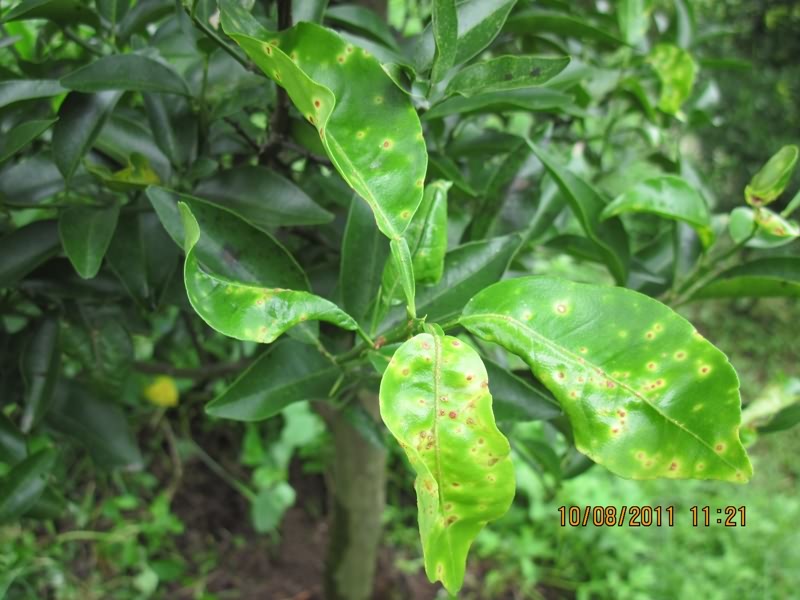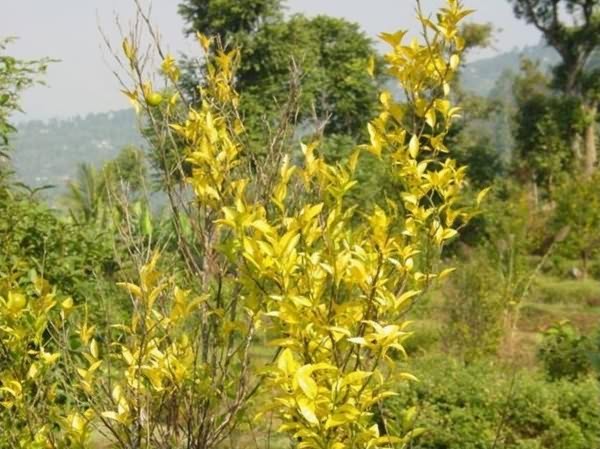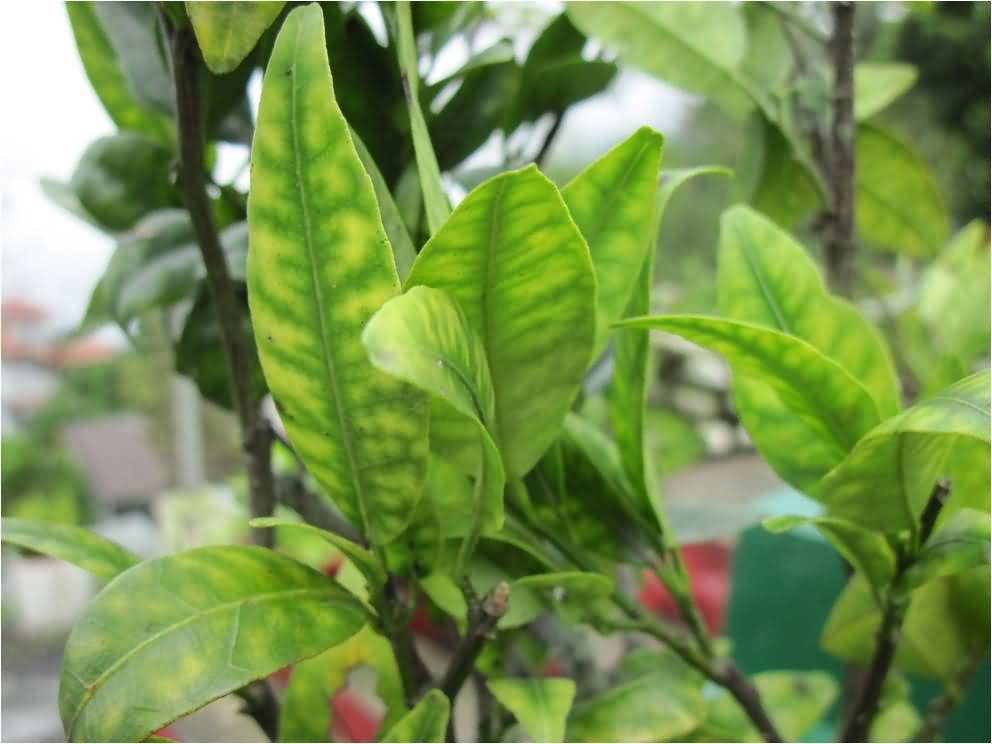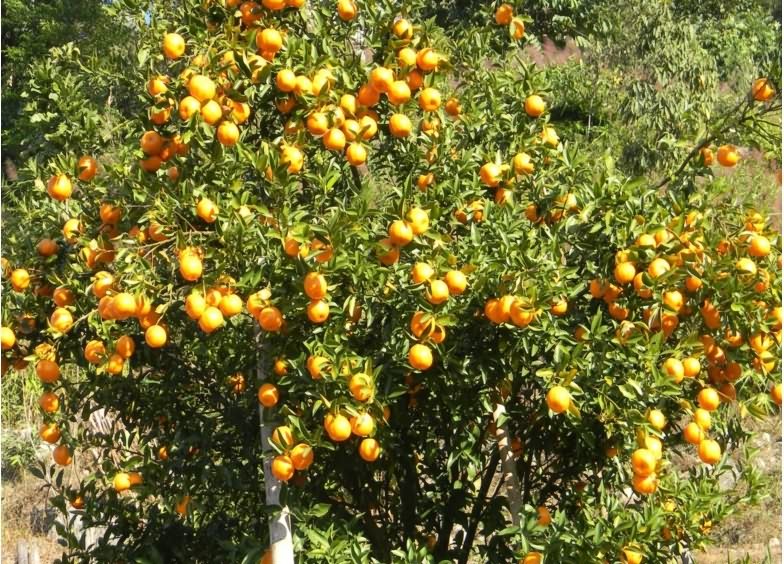 Fruit crops play an important role in the life of farmers of North Eastern hill regions. Fruit crops make hill agriculture vibrant and potentiate the economic condition of the farmers of this region.
Fruit crops play an important role in the life of farmers of North Eastern hill regions. Fruit crops make hill agriculture vibrant and potentiate the economic condition of the farmers of this region.
In Darjeeling region of West Bengal and Sikkim, cultivation of fruit crops mainly Darjeeling Mandarin is main source of livelihood for the farmers.
In India, every year a huge loss to citrus production occurs due to damage caused by insect pests, diseases and off course physiological disorders.
All these factors together cause a great damage to citrus crops; and growers as well as consumers are disadvantaged with it.
A. Disease Pests and their Management:
The diseases are caused by fungi, bacteria, virus, virus like pathogens, etc. They cause severe damage to the mandarin orange cultivation. The major diseases affecting citrus crops in Darjeeling and Sikkim regions are as follows:
1. Gummosis disease (Causal organism: Phytophthora palmivora, P. citrophthora, P. nicotianae var. parasitica):
The characteristic symptom of the disease is exudation of gum from bark of the tree trunk. The leaves of affected plants, turn yellow and show blight symptoms.
The bark shows conspicuous brown staining along with hardened masses of gum on the surface. The bark cracks open and in the later stages dry up and fall off, exposing the wood for secondary infection by other microorganisms.
In severe cases, the bark is destroyed by complete rotting, the trunk exhibits a characteristic girdling and the tree eventually dies. Prior to death, the plant usually blossoms heavily and dies before the fruits mature. In such cases, the disease is called collar rot or foot rot.
Management:
- Preventive measures like selection of site with proper drainage, avoiding direct contact of irrigation water with the trunk by adopting double ring irrigation method; and use of resistant rootstock such as sour orange (Citrus aurantium), trifoliate orange and Rangpur lime are effective against the disease.
- The budding should be done on rootstock at 35–40 cm height.
- Injuries to the plants should be avoided.
- After scraping the diseased parts with a sharp knife, the cut portions should be protected with Ridomil MZ-68 paste (20g in 1 L of linseed oil) or copper fungicides paste followed by 3–5 spraying with 0.3% Copper oxychloride or 0.2% Ridomil MZ at 15 days interval reduces disease spread effectively.
- Soil drenching with 0.2% Metalaxyl MZ-72 + 0.5% Trichoderma viride commercial formulation is also effective in managing the disease.
- The trunk should be painted with Bordeaux paste up to 50-75 cm height from the ground level at least once a year.
 2. Powdery mildew (Causal organism: Acrosporium tingitaninum):
2. Powdery mildew (Causal organism: Acrosporium tingitaninum):
The disease appears as white, cottony or powdery growth on all aerial parts of the affected plant. The affected leaves show yellowing and crinkling; and they have distorted margins.
The cottony growth becomes black and severely affected leaves dry up or drops off prematurely. The symptoms are more severe on the upper surface of the leaves, but are also present on the lower surface.
In severe infections, young fruits also get covered by mildew growth and drop off prematurely. Consequently the yield is reduced considerably.
Management:
- The affected parts should be removed and destroyed carefully.
- Immediately, after the cottony growth is observed spraying of 0.3% Sulfex or 0.2% Carbendazim, three times at 15-20 days interval effectively controls the disease.
- Sulphur dusting (25kg/hectare) in the morning hours controls the disease effectively.
- Sprays with fungicides like 0.1% Calixin (Tridemorph) or Thiovit @ 2.5 g/ L water or Karathane @ 2–3 ml or 0.25% wettable sulpur or 0.1% Dinocap gives satisfactory and prolonged control of the disease.
- The spraying should be repeated, if necessary at 10–15 days interval.
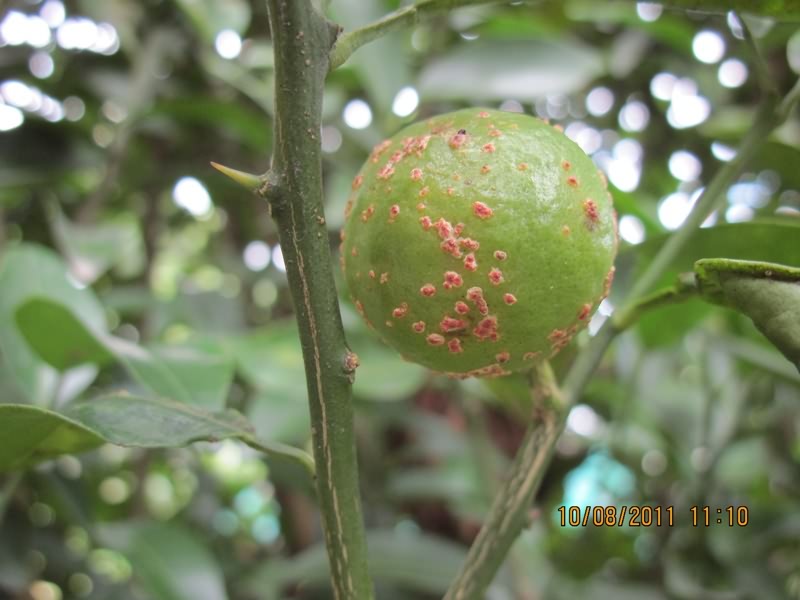 3. Citrus canker disease (Causal organism: Xanthomonas axonopodis pv. citri)
3. Citrus canker disease (Causal organism: Xanthomonas axonopodis pv. citri)
It is most serious bacterial disease of citrus crops during rainy season and it can cause severe losses. The disease appears on leaves, twigs, petioles, branches, fruits, fruit-stalks and thorns.
Initially, the symptoms on leaves appear as yellowish, small, raised translucent spots/ lesions, which gradually enlarge 2-4 mm in diameter and appear as raised rough brownish pustules.
Later, the epidermis over the spot ruptures to expose a crater-like spongy, tan-coloured tissue. A characteristic yellow halo surrounds the spot till it becomes old. Old lesions are corky, irregular in shape and brown in colour.
Severely affected leaves drop off prematurely. On the twigs the lesions appear water-soaked and dark green first and later turn brown. The pustules on twigs are corky, but without crater-like depression. In severe cases, the twigs dry up.
The infection on fruit appears as water-soaked lesions, similar to those on leaves except for the yellow halo. In the advanced stage these lesions show crater-like depressions.
The fruit lesions become rough and corky and sometimes cause cracks and fissures of the skin. Cankered fruits drop off prematurely.
Canker lesions are confined to the rind only and do not penetrate into the flesh of the fruit. The marketability of the infected fruits is seriously affected.
- The disease incidence can be reduced at farmers' field by pruning all the canker affected twigs before monsoon and burning them.
- The pruned branches or other plant's parts should be protected by paste of copper fungicides (e.g. Blitox–50) to prevent the further spread of this disease.
- After pruning 2–3 spraying of copper fungicides e.g. 0.3% Blitox–50 along with streptomycin sulphate 500-1000 ppm (0.5–1.5g per L of water) after onset of the monsoon is quite effective to check this disease. Spraying the crop with 0.2% Mancozeb is also helpful in reducing the disease incidence.
- Spray of Phytomycin antibiotic @1500 ppm in combination with 0.3% Copper oxychloride also helps in the management of the disease in the beginning of monsoon.
The disease is caused by Citrus Tristiza Virus (CTV). This disease is primarily spread through the use of diseased bud-wood.
Citrus aphid (Toxoptera citricida), vector of the disease transmits this virus in the healthy orchards.
The symptoms begin with the dieback of small branches and twigs, yellowing of leaves and heavy bearing of small fruits. As the disease advances, severe chlorosis and mottling can be seen.
The roots of the affected plants start rotting and plants die. After 7-8 years, the branches of the affected plant dry up severely and the plants wilt completely. Few trees show wilting symptoms overnight and completely dry up in 2 or 3 days.
Hence, Tristeza is also called a 'quick decline' disease. This disease may present independently or along with citrus greening disease. CTV infected diseased young trees tend to flower a year or two earlier than the healthy plants and their fruits are small in size and develop colour early.
In acid lime, vein fleckings or clearing and stem pittings are observed. Affected acid lime trees decline gradually. Bark splitting of lime twigs has also been observed.
Sweet orange varieties are symptom-less carriers but their susceptible root stock of budings show stem pits. Mandarin oranges grown from seed, show the disease symptoms like leaf fall, twig die-back, stem pitting, etc.
Management:
- Healthy and certified bud-wood should be used.
- Proper tillage practices, adequate drainage and improved soil fertility help to avoid the disease incidence.
- Resistant root stock such as trifoliate orange, Rangpur lime and Cleopatra mandarin should be used for vegetative propagation.
- Nucellar seedlings remain free from Citrus Tristeza Virus. It can be used as effective means to avoid this disease.
- Aphids, which are vector of Citrus Tristeza Virus should be destroyed by spraying the crop with Diamethoate or Monocrotophos @ 1.5 ml/L of water.
- Spraying the crop with Malathion @ 2.5 ml/L of water or Imidachloprid @ 0.25ml/L of water or Thiamethoxam @ 0.25 g/L of water or Acetamiprid @ 0.3 g/L of water may be used for effective control. Besides these NSKE @ 3-5 ml/L of water may also be used for satisfactory control of the citrus aphids.
This disease is wide-spread and so acute in India that there is a danger of destruction of Indian origin citrus species. The causal agent of this disease is phloem limited bacterium.
This disease is spread through grafting and citrus psylla (Diaphorina citri). In this disease, varied chlorotic patterns on leaves are noticed.
Veins of affected leaves turn yellow, leaves remain undersized and foliage become leathery and turns dull green. Heavy leaf fall occurs with the onset of summer.
Affected trees are stunted with pronounced leaf and fruit drop. Some branches on affected tree, exhibit severe twig dieback symptoms, whereas the others remain apparently normal.
The fruits of affected trees remain mostly green even on maturity and if directly exposed to sun they show a conspicuous yellow patch on the rind surface.
Diseased fruits are valueless owing to small size, distortion, low juice and insipid taste. Sweet orange, grapefruit and kagzi lime are indicator of this disease.
Management:
- The bud wood should be free from the greening disease preferably from mature seedling trees duly indexed for the disease.
- Spraying the crop with Fenvalerate @ 1 ml/L of water or Metasystox @ 2 ml/L of water or Profenophos @ 3 ml/L of water or Thiamethoxam @ 0.2 g/L of water gives effective control of citrus psyllids.
- Temporary suppression of the disease is possible by injecting the infected plants with Tetracycline 500 ppm or spraying the crop with Bavistin @ 500ppm + Ladermycin @ 500 ppm in 1 litre of water.
6. Citrus scab (Causal organism: Eisinoe fawcetti):
Scab is one of the major diseases in the hilly tracts where low temperature and high humidity prevail. It is common in Darjeeling hills, Sikkim, Assam and other North Eastern States. The disease attacks on leaves, twigs and fruits. Small, raised, corky lesions appear usually on the underside on the leaves.
The affected leaves often become distorted, wrinkled, stunted and de-shaped. The opposite surface corresponding to the warty growth shows a circular depression with a pink to red centre. The twig infection also results in similar lesion and the affected twigs are ultimately killed.
On the fruits, scabby or corky lesions develop and they soon coalesce affecting larger area on the fruits. The surface becomes rough and distorted and fruit may drop off prematurely. Humidity and rainfall play a very important role in the development of scab.
Management:
- The diseased leaves, twigs and fruits should be collected and destroyed.
- After pruning and destruction of the diseased leaves, twigs, branches and fruits; spraying the crop with 0.3% Copper oxychloride or 0.2% Carbendazim are helpful in controlling the disease.
7. Anthracnose or wither tip/die back (Causal organism: Colletotrichum gloeosporioides):
In this disease leaves, young shoots and tender fruits are often attacked. Affected leaves turn yellow, show necrotic patches with distortions. The disease severely affects branches, which starts to wither from the tip downwards.
The drying back gradually progresses downward with leaves turning yellow, withering and drooping and gum formation on the stem. Dead pans of the twigs assume silvery grey appearance. Fruit drop occurs in the severe stages.
Management:
- Pruning of diseased twigs and its protection with copper fungicide (e.g. Blitox–50) paste is quite effective in checking this disease.
- Spraying of Blitox–50 (2.5g/L of water) or Mancozeb (2.0 g/L of water) is very effective against this disease. Spray of 0.2% Zineb or 0.2% Captan also helps to minimize the disease.
- Proper irrigation and need based use of fertilizers especially nitrogenous fertilizer helps to avoid the disease.
Summary
Citrus especially Darjeeling mandarin is one of the most important fruit crops of Darjeeling and Sikkim hills of North Eastern region of Himalaya. It plays an important role in providing energy, food and certain vitamins. Besides, it is a good source of income for the growers especially in these challenged areas.
Off-course several devastating diseases such as gummosis, powdery mildew, canker disease, citrus tristeza, citrus greening etc. and many insects pests attack on the citrus crops but timely use of management tools for their effective management in these regions can really help to uplift the farmers’ economic condition to a greatest extent.
Table 1: Recommended fungicides & pesticides for the management of diseases and insect pests in Mandarin orange**
| Target Disease / Pest | Fungicides/ Pesticides | Dose (g/L or ml/L)of most common formulation* | Method of application |
| Gummosis disease | Ridomil MZ | 2.0 | Foliar spraying |
| Copper oxychloride | 3.0 | Foliar spraying | |
| Ridomil MZ | 20 | Apply as paste | |
| Powdery mildew | Sulfex | 3.0 | Foliar spraying |
| Karathane | 2.0 - 3.0 | Foliar spraying | |
| Citrus canker | Blitox–50 + Streptomycin sulphate | 3.0 + 0.5 – 1.5 | Foliar spraying |
| Mancozeb | 2.0 | Foliar spraying | |
| Citrus Tristeza Disease | Diamethoate | 1.5 | Foliar spraying |
| Malathion | 2.5 | Foliar spraying | |
| Citrus Greening disease | Fenvalerate | 1.0 | Foliar spraying |
| Profenophos | 3.0 | Foliar spraying | |
| Citrus scab | Copper oxychloride | 3.0 | Foliar spraying |
| Carbendazim | 2.0 | Foliar spraying | |
| Anthracnose/die back | Blitox–50 | 2.5 | Foliar spraying |
| Mancozeb | 2.0 | Foliar spraying | |
| Citrus leaf miner | Dimethoate | 2.0 | Foliar spraying |
| profenofos | 2.0-3.0 | Foliar spraying | |
| Citrus psylla | Fenvalerate | 1.0 | Foliar spraying |
| Phosalone | 1.5 – 2.0 | Foliar spraying | |
| Thiamethoxam | 0.2 | Foliar spraying | |
| Citrus Fruit flies | Carbaryl | - | Dusting |
| Lemon butterfly | Chlorpyrifos | 3.0 | Foliar spraying |
| Carbaryl | 2.5 | Foliar spraying | |
| Fruit sucking moths | Rynaxypyr | 0.33 | Foliar spraying |
| Flubendiamide | 0.25 | Foliar spraying | |
| Citrus Aphids | Malathion | 2.5 | Foliar spraying |
| Imidacloprid | 0.25–0.50 | Foliar spraying | |
| Shoot borer /trunk borer | Quinalphos | 1.5 | Foliar spraying |
| Carbaryl | 2.0 | Foliar spraying | |
| Dichlorvos | 5.0 | Swabbing of insect tunnels |
*Indicative dose given for convenience of famers **Details available in the article
Authors:
Ravindra Kumar*, Amalendu Ghosh, Amrita Das and Ramu Meena
ICAR-Indian Agricultural Research Institute, Regional Station, Kalimpong –734301 (W.B.)
* Present Address: ICAR-Indian Agricultural Research Institute, Regional Station, Karnal – 132001 (Haryana)
*Email-

